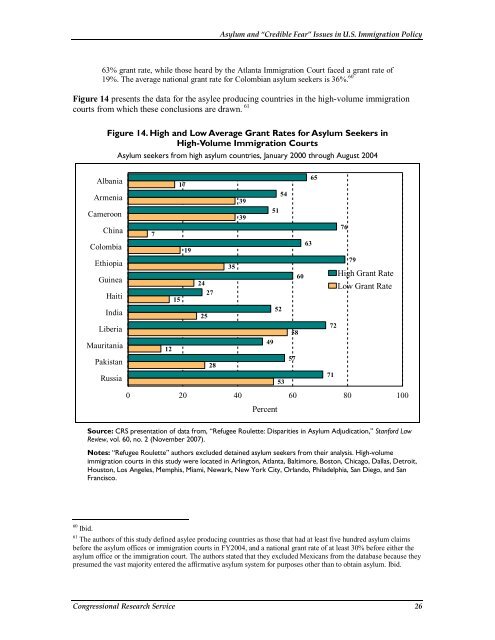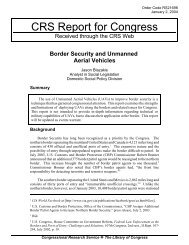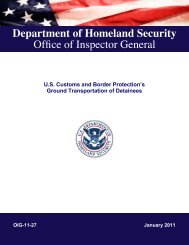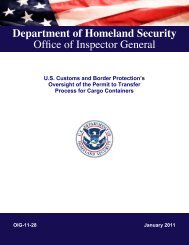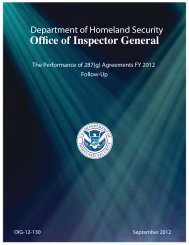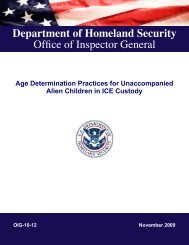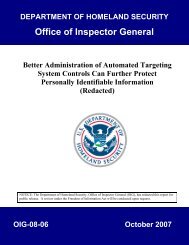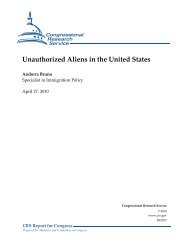<strong>Asylum</strong> <strong>and</strong> “<strong>Credible</strong> Fear” <strong>Issues</strong> <strong>in</strong> U.S. <strong>Immigration</strong> <strong>Policy</strong>63% grant rate, while those heard by the Atlanta <strong>Immigration</strong> Court faced a grant rate of19%. The average national grant rate for Colombian asylum seekers is 36%. 60Figure 14 presents the data for the asylee produc<strong>in</strong>g countries <strong>in</strong> the high-volume immigrationcourts from which these conclusions are drawn. 61Figure 14. High <strong>and</strong> Low Average Grant Rates for <strong>Asylum</strong> Seekers <strong>in</strong>High-Volume <strong>Immigration</strong> Courts<strong>Asylum</strong> seekers from high asylum countries, January 2000 through August 2004AlbaniaArmeniaCameroonCh<strong>in</strong>aColombiaEthiopiaGu<strong>in</strong>eaHaitiIndiaLiberiaMauritaniaPakistanRussia717191512242725283539396554516360525849575372717679High Grant RateLow Grant Rate0 20 40 60 80 100PercentSource: CRS presentation of data from, “Refugee Roulette: Disparities <strong>in</strong> <strong>Asylum</strong> Adjudication,” Stanford LawReview, vol. 60, no. 2 (November 2007).Notes: “Refugee Roulette” authors excluded deta<strong>in</strong>ed asylum seekers from their analysis. High-volumeimmigration courts <strong>in</strong> this study were located <strong>in</strong> Arl<strong>in</strong>gton, Atlanta, Baltimore, Boston, Chicago, Dallas, Detroit,Houston, Los Angeles, Memphis, Miami, Newark, New York City, Orl<strong>and</strong>o, Philadelphia, San Diego, <strong>and</strong> SanFrancisco.60 Ibid.61 The authors of this study def<strong>in</strong>ed asylee produc<strong>in</strong>g countries as those that had at least five hundred asylum claimsbefore the asylum offices or immigration courts <strong>in</strong> FY2004, <strong>and</strong> a national grant rate of at least 30% before either theasylum office or the immigration court. The authors stated that they excluded Mexicans from the database because theypresumed the vast majority entered the affirmative asylum system for purposes other than to obta<strong>in</strong> asylum. Ibid.Congressional Research Service 26
<strong>Asylum</strong> <strong>and</strong> “<strong>Credible</strong> Fear” <strong>Issues</strong> <strong>in</strong> U.S. <strong>Immigration</strong> <strong>Policy</strong>U.S. Government Accountability Office (GAO)The U.S. Government Accountability Office (GAO) analyzed the disparity <strong>in</strong> asylum decisions aswell <strong>and</strong> found that “significant variation existed.” GAO performed multivariate statisticalanalyses on asylum cases from 19 immigration courts that h<strong>and</strong>led almost 90% of the cases fromOctober 1994 through April 2007. GAO identified n<strong>in</strong>e factors that affected these outcomes:(1) filed affirmatively (orig<strong>in</strong>ally with DHS at his/her own <strong>in</strong>itiative) or defensively (withDOJ, if <strong>in</strong> removal proceed<strong>in</strong>gs); (2) applicant’s nationality; (3) time period of the asylumdecision; (4) representation; (5) applied with<strong>in</strong> 1 year of entry to the United States; (6)claimed dependents on the application; (7) had ever been deta<strong>in</strong>ed (defensive cases only); (8)gender of the immigration judge; <strong>and</strong> (9) length of experience as an immigration judge. 62GAO then statistically controlled for these n<strong>in</strong>e factors <strong>and</strong> found disparities across immigrationcourts <strong>and</strong> judges: “For example, affirmative applicants <strong>in</strong> San Francisco were still 12 times morelikely than those <strong>in</strong> Atlanta to be granted asylum. Further, <strong>in</strong> 14 of 19 immigration courts foraffirmative cases, <strong>and</strong> 13 of 19 for defensive cases, applicants were at least 4 times more likely tobe granted asylum if their cases were decided by the judge with the highest versus the lowestlikelihood of grant<strong>in</strong>g asylum <strong>in</strong> that court.” 63GAO also found that the grant rate for affirmative cases exceeded 50% for asylum seekers fromcountries such as Albania, the PRC, Ethiopia, Iran, Russia, Somalia, <strong>and</strong> the former Yugoslavia.In contrast, GAO found that the grant rate for affirmative cases was lower than 10% for asylumseekers from El Salvador, Guatemala, Honduras, <strong>and</strong> Mexico. In terms of defensive cases, GAOobserved that about 50% of asylum seekers from Iran <strong>and</strong> Ethiopia were granted asylum <strong>and</strong>almost 60% of such cases from Somalia were granted asylum. However, this outcome occurredfor 13% or less of the defensive asylum cases from El Salvador, Honduras, <strong>and</strong> Indonesia. 64 GAOalso offered the follow<strong>in</strong>g important caveat:Because data were not available on the facts, evidence, <strong>and</strong> testimony presented <strong>in</strong> eachasylum case, nor on immigration judges’ rationale for decid<strong>in</strong>g whether to grant or deny acase, we could not measure the effect of case merits on case outcomes. However, the size ofthe disparities <strong>in</strong> asylum grant rates creates a perception of unfairness <strong>in</strong> the asylumadjudication process with<strong>in</strong> the immigration court system. 65Transactional Records Access Clear<strong>in</strong>ghouse (TRAC)Researchers at Syracuse University’s TRAC have been conduct<strong>in</strong>g analyses of the immigrationcourts for several years <strong>and</strong> were among the earliest to identify wide variations <strong>in</strong> asylumoutcomes that were dependent on the immigration judge. “The typical judge-by-judge denialrate—half denied more <strong>and</strong> half denied less—was 65% . There were, however, eight judges who62 U.S. Government Accountability Office (GAO), U.S. <strong>Asylum</strong> System: Significant Variation Existed <strong>in</strong> <strong>Asylum</strong>Outcomes across <strong>Immigration</strong> Courts <strong>and</strong> Judges, GAO-08-940, September 2008, http://www.gao.gov/new.items/d08940.pdf.63 Ibid.64 Ibid.65 Ibid.Congressional Research Service 27


